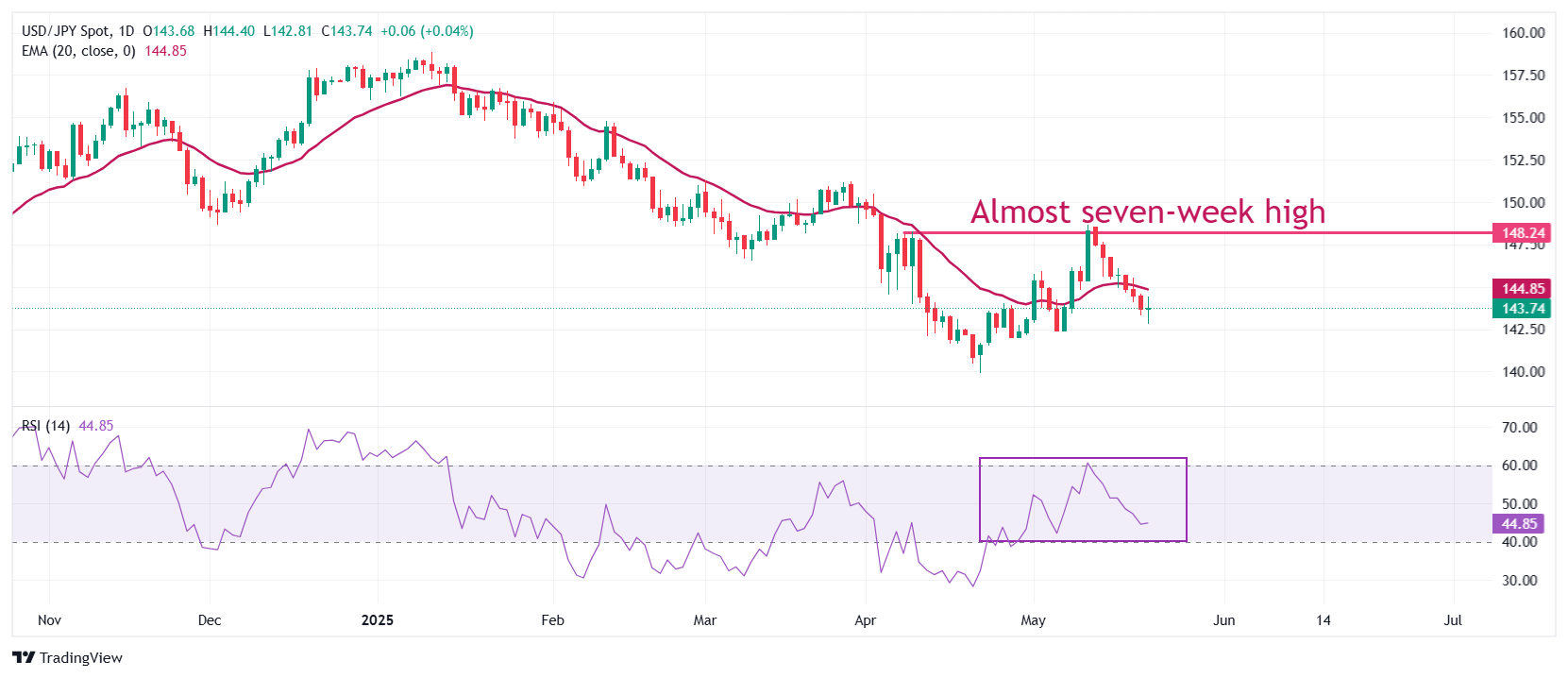USD/JPY Price Forecast: Flattens around 143.50
- USD/JPY rebounds and turns flat around 143.50 as the US Dollar claws back early losses.
- Mounting US fiscal deficit concerns are expected to keep the US Dollar on the backfoot.
- Japan’s Akazawa is scheduled to visit Washington over the weekend for the third round of trade talks.
The USD/JPY pair recoups its initial losses and flattens around 143.50 during European trading hours on Thursday. The pair rebounds as the US Dollar (USD) attracts bids on Thursday after a three-day losing streak. The US Dollar Index (DXY), which tracks the Greenback’s value against six major currencies, recovers to near 99.85 from the two-week low of 99.35 posted on Wednesday.
The Greenback suffered in the past few trading days due to accelerating concerns over the already imbalanced United States (US) fiscal deficit. On Wednesday, US President Donald Trump’s tax-cut and spending bill was approved by the Republican-controlled House Rules Committee and advanced to a floor vote, which is expected to add $3.8 trillion to the overall national debt over the decade. This will escalate the already worsening US fiscal crisis and increase interest obligations for the government.
On the economic data front, investors await the flash US S&P Global Purchasing Managers’ Index (PMI) data for May, which will be published at 13:45 GMT.
On the global front, investors await trade talks between the US and Japan later this week. This will be the third round of trade discussions. Japan’s top trade negotiator, Ryosei Akazawa, is scheduled to visit Washington over the weekend.
USD/JPY extends its downside below the 20-day Exponential Moving Average (EMA), which is around 144.85, indicating that the near-term trend is bearish.
The 14-day Relative Strength Index (RSI) oscillates inside the 40.00-60.00 range, suggesting a sideways trend.
An upside move in the pair towards the psychological level of 150.00 and the March 28 high of 151.21 would come if it breaks above the May 13 high of 148.57.
The asset would face more downside towards the April 22 low of 139.90 and the 14 July 2023 low of 137.25 if it breaks below the May 7 low of 142.42.
USD/JPY daily chart

US Dollar FAQs
The US Dollar (USD) is the official currency of the United States of America, and the ‘de facto’ currency of a significant number of other countries where it is found in circulation alongside local notes. It is the most heavily traded currency in the world, accounting for over 88% of all global foreign exchange turnover, or an average of $6.6 trillion in transactions per day, according to data from 2022. Following the second world war, the USD took over from the British Pound as the world’s reserve currency. For most of its history, the US Dollar was backed by Gold, until the Bretton Woods Agreement in 1971 when the Gold Standard went away.
The most important single factor impacting on the value of the US Dollar is monetary policy, which is shaped by the Federal Reserve (Fed). The Fed has two mandates: to achieve price stability (control inflation) and foster full employment. Its primary tool to achieve these two goals is by adjusting interest rates. When prices are rising too quickly and inflation is above the Fed’s 2% target, the Fed will raise rates, which helps the USD value. When inflation falls below 2% or the Unemployment Rate is too high, the Fed may lower interest rates, which weighs on the Greenback.
In extreme situations, the Federal Reserve can also print more Dollars and enact quantitative easing (QE). QE is the process by which the Fed substantially increases the flow of credit in a stuck financial system. It is a non-standard policy measure used when credit has dried up because banks will not lend to each other (out of the fear of counterparty default). It is a last resort when simply lowering interest rates is unlikely to achieve the necessary result. It was the Fed’s weapon of choice to combat the credit crunch that occurred during the Great Financial Crisis in 2008. It involves the Fed printing more Dollars and using them to buy US government bonds predominantly from financial institutions. QE usually leads to a weaker US Dollar.
Quantitative tightening (QT) is the reverse process whereby the Federal Reserve stops buying bonds from financial institutions and does not reinvest the principal from the bonds it holds maturing in new purchases. It is usually positive for the US Dollar.


